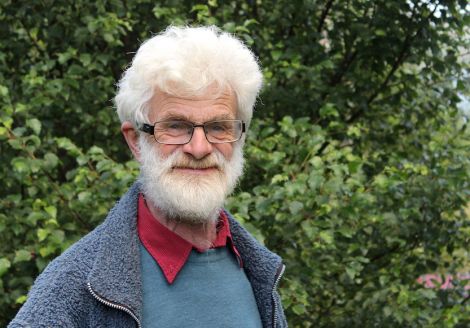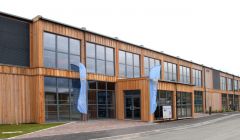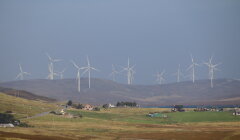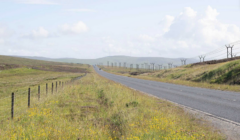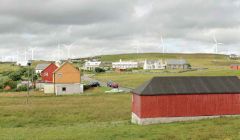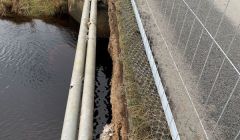News / Planning committee tasked to consider Viking’s turbine increase application
Council is a consultee on wind farm variation
MEMBERS of the Shetland Islands Council planning committee have been challenged by anti wind farm campaigners to “be brave” at a meeting on Wednesday where they will consider an application to increase the size of turbines at the Viking Wind Farm.
A letter from Sustainable Shetland (SuS) vice chairman James Mackenzie to members of the planning committee says that they have the chance to “right the wrongs that have been done to these people” who live around the planned wind farm.
Viking is proposing to increase the diameter of its turbine rotor blades by 10m to 120m while increasing the overall height of each windmill by 10m to 155m.
A report by development planning officer Richard MacNeill recommends that the council, as a statutory consultee, makes no objections to the development subject to any conditions necessary in order to comply with the local development plan.
A final decision on the variation of Viking Energy’s original plans, approved in April 2012, will be made by the Energy Consents Unit in Glasgow.
The council report says: “On balance it is considered that the economic and environmental benefits of carbon reduction outweigh the impact on the landscape and habitat interests tempered with the knowledge that well designed mitigation measures will go some way to reduce any negative impacts.”
Although each of the proposed 103 turbines is to be bigger, the actual footprint of the Viking Wind Farm site will shrink slightly, according to the planning variation.
The report also says that increasing the turbine size will allow the project to benefit from “significant advances in wind turbine technology” since the original application was made 10 years ago.
It adds: “Increasing rotor diameter would enable a broader range of wind turbines to be tendered for the turbine supply contracts, improve the competitiveness of the procurement process and should help keep project capital costs down.
Become a member of Shetland News
“Building a more productive and efficient Viking Wind Farm increases the long term income generated by the project, aiming to improve returns to investors in the wind farm, that include Shetland Charitable Trust which has a 45 per cent community stake in the project.
“This variation would also increase the community benefit payments made by the windfarm due to a potentially larger installed generating capacity.”
It will also improve Viking’s chances of winning a contract to provide renewable energy to the UK when the Contract for Difference bidding process gets underway in May and enable the provision of “cheaper” power to the public.
Mackenzie’s letter says the planning committee “has the responsibility for deciding the possible future of Shetland”, when it considers the variation.
It says that the crucial point is “what constitutes an unacceptable impact on people – and which people. May we at least agree that by and large it is those people who would be living in the vicinity of the proposed development? And that if they find the development unacceptable their views should at least be respected?”
The letter adds that SuS was “formed not as a result of some rabble-rousing and scaremongering zealots, as some councillors and trustees of Shetland Charitable Trust have tried to smear it, but because folk, including crofters that would gain financially from the development – who would have to live in close proximity to – or indeed within – the wind farm – believed this was unacceptable, and feared their voices were not being listened to by their elected representatives. Many people agreed with them.
“Genuine concerns not just about environmental degradation and loss of amenity, but about health impacts contributed to this unacceptability.
“The ill-health of people however has been dismissed by the developer as not worthy of consideration, even though there is evidence (commissioned by the developer) that large wind farms do have ill-health effects.”
It quotes a summary of a report by then director of public health in Shetland Dr Sarah Tayler saying wind farms are known to cause effects such as noise and shadow flicker which may cause annoyance, stress and sleep disturbance.
“Current mitigations do not entirely deal with the annoyance caused by wind farms, the results of which are a cause of distress and related ill health for a number of people living in the vicinity,” her summary adds.
Mackenzie’s letter adds: “The SIC planning committee has one last chance tomorrow to right the wrongs that have been done to these people, and to declare that the variation to the scheme is unacceptable, for a number of valid reasons.”
He also urges the committee to consider the “cumulative impact” of several more large wind farms that could be built on Shetland’s peatlands if the VE project and interconnector go ahead.
It also quotes a caveat in the planning report that the council could stall approval until an acceptable lighting scheme for the wind farm is agreed with the Civil Aviation Authority.
“Members may also consider the prospect of 103 turbines, with an overall height of 155 metres, all over the central mainland being permanently illuminated for aviation safety,” it adds.
Become a member of Shetland News
Shetland News is asking its readers to consider paying for membership to get additional perks:
- Removal of third-party ads;
- Bookmark posts to read later;
- Exclusive curated weekly newsletter;
- Hide membership messages;
- Comments open for discussion.
If you appreciate what we do and feel strongly about impartial local journalism, then please become a member of Shetland News by either making a single payment, or setting up a monthly, quarterly or yearly subscription.





